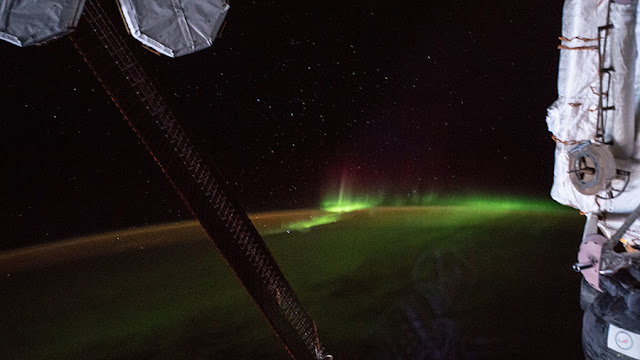ISS — Expedition 59 Mission patch.
April 25, 2019
Vein scans and eye checks were on the schedule today as the Expedition 59 crew continues ongoing biomedical studies. The International Space Station is also getting ready to host a sixth spacecraft when it arrives next week.
Scientists have been observing the space residents all week as they seek to understand the effects of the upward flow of body fluids in space. Flight Engineer Anne McClain worked on the Fluid Shifts experiment again today attaching body electrodes to NASA astronaut Nick Hague and conducting ultrasound scans of his veins. She also peered into his eyes using optical tomography coherence hardware. Results may help flight surgeons prevent the increased head and eye pressure caused by the upward fluid shifts astronauts report in space.
Image above: The aurora australis, also known as the “southern lights”, is pictured as the International Space Station orbited 265 miles above the Indian Ocean southwest of Australia. Image Credit: NASA.
NASA is also learning how to support longer human missions farther out into space. Feeding crews without expensive cargo missions and fuel-consuming inventories is critical. As a result, the station provides a variety of greenhouse facilities for plant cultivation and research. Christina Koch of NASA set up new botany hardware today to enable the ongoing research and harvesting of lettuce and mizuna in space.
Image above: On April, 22, 2019, the crew aboard the International Space Station snapped this image of the Hudson Bay’s frozen southern tip, which lies in between Ontario and Quebec, as the Space Station orbited 258 miles above Canada. Image Credit: NASA.
The SpaceX Dragon resupply ship is due to liftoff Tuesday at 4:21 a.m. EDT on its 17th contracted cargo mission to the station. Canadian Space Agency astronaut David Saint-Jacques is training to capture Dragon with the Canadarm2 robotic arm when it arrives Thursday May 2 at 6:50 a.m. A pair of new experiments it is delivering will explore atmospheric carbon dioxide as well as X-ray frequency communication techniques.
NASA to Broadcast Next Space Station Resupply Launch, Prelaunch Activities
Launch time has been updated to 4:21 a.m. EDT and spacecraft capture now is set for 6:50 a.m. NASA TV coverage off capture will begin at 5 a.m. (Updated April 25, 2019)
NASA commercial cargo provider SpaceX is targeting no earlier than 4:21 a.m. EDT Tuesday, April 30, for the launch of its next resupply mission to the International Space Station. Live coverage will begin on NASA Television and the agency’s website Monday, April 29, with prelaunch events.
This is the 17th SpaceX mission under NASA’s Commercial Resupply Services contract. The Dragon spacecraft will deliver supplies and critical materials to support dozens of the more than 250 science and research investigations that will occur during Expeditions 59 and 60. The spacecraft’sunpressurized trunk will transport NASA’s Orbiting Carbon Observatory-3 (OCO-3) and Space Test Program-Houston 6 (STP-H6).
Image above: A two-stage SpaceX Falcon 9 launch vehicle lifts off from Space Launch Complex 40 at Cape Canaveral Air Force Station in Florida on December 5, 2018 at 1:16 p.m. EST, carrying the 16th Commercial Resupply Services mission to the International Space Station. Image Credit: NASA.
OCO-3 will be installed robotically on the exterior of the space station’s Japanese Experiment Module Exposed Facility Unit, where it will measure and map carbon dioxide from space to increase our understanding of the relationship between carbon and climate. STP-H6 is an X-ray communication investigation that will be used to perform a space-based demonstration of a new technology for generating beams of modulated X-rays. This technology may be useful for providing efficient communication to deep space probes, or communicating with hypersonic vehicles where plasma sheaths prevent traditional radio communications.
The spacecraft will take two days to reach the space station before installation on Thursday, May 2. When it arrives, astronaut David Saint-Jacques of the Canadian Space Agency will grapple Dragon, with NASA astronaut Nick Hague serving as backup. NASA astronaut Christina Koch will assist by monitoring telemetry during Dragon’s approach. After Dragon capture, mission control in Houston will send commands to the station’s arm to rotate and install the spacecraft on the bottom of the station’s Harmony module.
Related article:
Dragon’s 17th Flight Carries Science to the Space Station
https://orbiterchspacenews.blogspot.com/2019/04/dragons-17th-flight-carries-science-to.html
Related links:
NASA Television: https://www.nasa.gov/live
Expedition 59: https://www.nasa.gov/mission_pages/station/expeditions/expedition59/index.html
Fluid Shifts: https://www.nasa.gov/mission_pages/station/research/experiments/explorer/Investigation.html?#id=1126
Lettuce and mizuna: https://www.nasa.gov/mission_pages/station/research/experiments/explorer/Investigation.html?#id=7581
Atmospheric carbon dioxide: https://www.nasa.gov/mission_pages/station/research/experiments/explorer/Investigation.html?#id=1786
X-ray frequency communication: https://www.nasa.gov/mission_pages/station/research/experiments/explorer/Investigation.html?#id=7947
Orbiting Carbon Observatory-3 (OCO-3): https://ocov3.jpl.nasa.gov/
Space Test Program-Houston 6 (STP-H6): https://www.nasa.gov/mission_pages/station/research/experiments/explorer/Investigation.html?#id=7947
Space Station Research and Technology: https://www.nasa.gov/mission_pages/station/research/index.html
International Space Station (ISS): https://www.nasa.gov/mission_pages/station/main/index.html
Images (mentioned), Text, Credits: NASA/Mark Garcia/Sean Potter/Josh Finch/Kennedy Space Center/Mary MacLaughlin.
Best regards, Orbiter.chArchive link








Комментариев нет:
Отправить комментарий